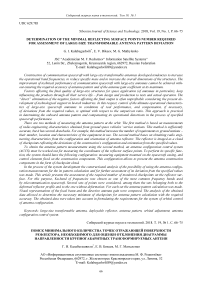Determination of the minimal reflecting surface points number required for assessment of large-size transformable antenna pattern deviation
Автор: Kalabegashvili G.I., Bikeev E.V., Mathylenko M.G.
Журнал: Сибирский аэрокосмический журнал @vestnik-sibsau
Рубрика: Авиационная и ракетно-космическая техника
Статья в выпуске: 1 т.19, 2018 года.
Бесплатный доступ
Construction of communication spacecraft with large-size transformable antennas developed tendencies to increase the operational band frequencies, to reduce specific mass and to increase the overall dimensions of the structures. The improvement of technical performance of communication spacecraft with large-size antennas cannot be achieved with- out ensuring the required accuracy of antenna pattern and of the antenna gain coefficient at its maximum. Factors affecting the final quality of large-size structures for space application (of antennas in particular), keep influencing the products through all their service life - from design and production to tests and actual operation. The “direct” elimination of the negative factors affecting the final output is often unprofitable considering the present de- velopment of technological support in hi-tech industries. In this respect, control of the ultimate operational characteris- tics of large-size spacecraft antennas in conditions of real performance, and compensation, if necessary, of deviations from the required values, is optimal with respect to the output/cost ratio. This approach is practical in determining the onboard antenna pattern and compensating its operational distortions in the process of specified spacecraft performance. There are two methods of measuring the antenna pattern at the orbit. The first method is based on measurements of radio engineering characteristics obtained from ground space vehicles’ service stations. This method is sufficiently accurate, but it has several drawbacks. For example, this method increases the number of requirements to ground stations - their number, location and characteristics of the equipment in use. The second method bases on obtaining radio engi- neering characteristics from the configuration and orientation of antenna reflector. The reflector is imaged as a cloud of checkpoints reflecting the deviations of the construction’s configuration and orientation from the specified values. To obtain the antenna pattern measurements using the second method, an antenna configuration control system (ACCS) must be worked out for measuring the coordinates of the reflector surface points. To perform its specific func- tion, the system should have the following configuration: measuring equipment mounted on the spacecraft casing, and control elements fixed on the construction components. This configuration allows to present the antenna construction components in the form of checkpoint cloud. In the process of the system development the constructional analysis of the possibility of using the antenna configu- ration measurements for the its pattern calculation and for further assessment of its deviation from the specified values was made. This article presents the assessment of the required number of monitored checkpoints on the reflector sur- face. For this purpose, Ku-band of frequencies was chosen as one of the most common frequency bands used by telecommunication spacecraft. Several sets of points were considered, among them the sets belonging both to the deformed reflector profile and to the one without deformation. For each set the antenna pattern calculation was made. Visual representations of the focal beam and the directive antenna gain were compared. The analysis of the obtained data allowed to determine the necessary minimum of checkpoints for antenna pattern calculation with the required accuracy. The obtained data were taken into account in formulating the requirements for the system of orbital control of antenna configuration.
Large-size transformable antenna, deployable reflector, antenna pattern, orbital adjustment, antenna configuration control system
Короткий адрес: https://sciup.org/148177803
IDR: 148177803 | УДК: 629.783
Список литературы Determination of the minimal reflecting surface points number required for assessment of large-size transformable antenna pattern deviation
- Гряник М. В., Ломан В. И. Развертываемые зеркальные антенны зонтичного типа. М.: Радио и связь, 1987. 72 с.
- Tibert G. Deployable tensegrity structures for space applications . Doctoral thesis Stockholm: Royal Institute of Technology, 2002. URL: http://www.mech.kth.se/thesis/2002/phd/phd_2002_gunnar _tibert.pdf.
- Кочержевский Г. Н., Ерохин Г. А., Козырев Н. Д. Антенно-фидерные устройства. М.: Радио и связь, 1989. 352 с.
- Пономарев С. В. Трансформируемые рефлекторы антенн космических аппаратов//Вестник ТГУ. Сер. «Математика и механика». 2011. Вып. 4(16). С. 111-119.
- Пат. № 2370864 Российская Федерация, H01Q15/16. Зонтичная антенна космического аппарата/Халиманович В. И., Величко А. И., Шипилов Г. В., Романенко А. В. и др. Заявл. 28.08.2008; опубл. 20.10.2009.
- Пат. № 2350519 Российская Федерация, B 64 G 1/22, H 01 Q 15/16. Развертываемый трансформируемый рефлектор космического аппарата/Тестоедов Н. А., Халиманович В. И., Величко А. И., Шипилов Г. В., Романенко А. В. и др. Заявл. 13.06.2007; опубл. 27.03.2009.
- Механика больших космических конструкций/Н. В. Баничук . М.: Факториал, 1977. 302 с.
- Бей Н. А., Зимин В. Н. Трансформируемые Антенны больших размеров для геостационарных космических аппаратов//Антенны. 2005. № 10. C. 24-27.
- Способ компенсации деформаций конструкции крупногабаритной антенны космического аппарата/Е. В. Бикеев, Е. Н. Якимов, М. Г. Матыленко, Г. П. Титов//Вестник СибГАУ. 2014. Т. 17, № 3. С. 673-683.
- Система контроля геометрии крупногабарит-ной трансформируемой антенны и ее наведение/М. Г. Матыленко //Решетневские чтения: материалы XVII Междунар. науч. конф. В 2 ч. Ч. 1/под общ. ред. Ю. Ю. Логинова; Сиб. гос. аэрокосмич. ун-т. Красноярск, 2013. C. 194-196.
- Rodrigues G., Angevain J-C., Prowald J. S. Active shape control of reconfigurable antenna reflectors//Advanced Lightweight Structures and Reflector Antennas: Proceedings of the 2nd Intern. Conf. 2014.
- Sabatini M. Operational modal analysis via image based technique of very flexible space structures//Acta Astronautica. 2013. Т. 89. С. 139-148.
- Sabatini M. Image based control of the "PINOC-CHIO" experimental free flying platform//Acta Astro-nautica. 2014. Т. 94, № 1. С. 480-492.
- Шендалев Д. О. Применение комплекса конечно-элементного моделирования ANSYS при разработке крупногабаритных трансформируемых рефлекторов//Решетневские чтения: материалы XIX Междунар. науч. конф. В 2 ч. Ч. 1/Сиб. гос. аэрокосмич. ун-т. Красноярск, 2015. С. 95-96.
- Пат. № 2423759 Российская Федерация, H 01 Q 15/00. Зонтичная антенна космического аппарата/Тестоедов Н. А., Халиманович В. И., Величко А. И., Леканов А. В. и др. Заявл. 08.03.2007; опубл. 10.07.2011.


